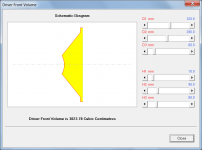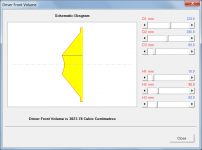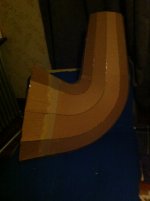Now get out the rice again and tell us how you can make a rear chamber for an 8" speaker of only 38 cc, just over an ounce shot glass sizeHere we go:
Last edited:
Now, fill the cone up with rice flat to the surround, and measure how much volume that is,
Alternatively, use the Hornresp Driver Front Volume tool.
Attachments
Well I can't give away all of my secrets! 
Thanks for pointing that out. I've landed on a Vrc of 4, and an Lrc of 10...which gives a fairly good response:

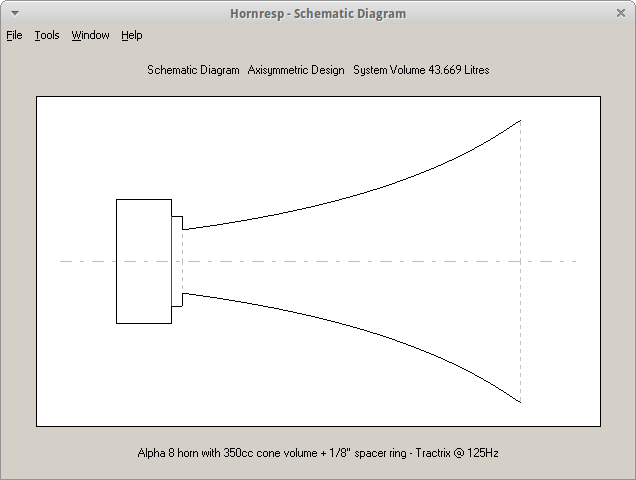
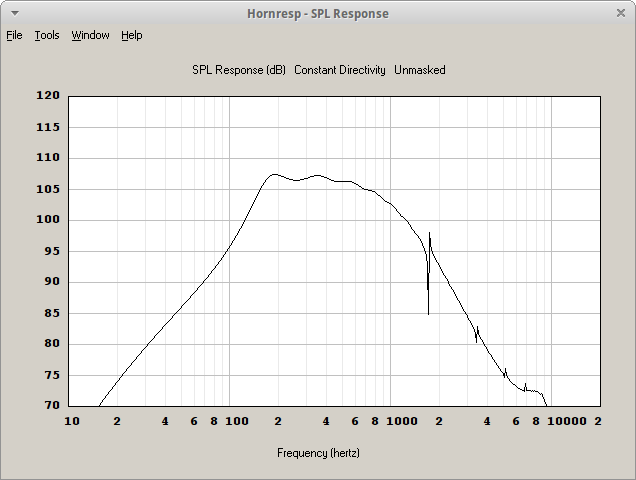
Given the relative size of the driver (imaging that it's flush-mounted to the throat of the horn), the volume would be realistic this time I've not yet started on the damping as you can see, as I didn't have any data for that to hand...
I've not yet started on the damping as you can see, as I didn't have any data for that to hand...
Edit: David, I didn't see your message until after posting this initially. I'll try that too, and see how the measurements differ...or match! Hornresp really does a lot - and as I get into the program a bit more, being able to chuck out designs into the real world quite directly is definitely a huge benefit of using it!
Thanks for pointing that out. I've landed on a Vrc of 4, and an Lrc of 10...which gives a fairly good response:



Given the relative size of the driver (imaging that it's flush-mounted to the throat of the horn), the volume would be realistic this time
Edit: David, I didn't see your message until after posting this initially. I'll try that too, and see how the measurements differ...or match! Hornresp really does a lot - and as I get into the program a bit more, being able to chuck out designs into the real world quite directly is definitely a huge benefit of using it!
Last edited:
I'll try that too, and see how the measurements differ...or match!
Hi unaHm,
I don't know about the rice method, but the Hornresp volume will be accurate to 1/100 of a cubic centimetre if the input dimensions are correct, the dust cone is a spherical cap, and the diaphragm cone surface is not curved
Kind regards,
David
Now get out the rice again and tell us how you can make a rear chamber for an 8" speaker of only 38 cc, just over an ounce shot glass size.
Just for the record Vrc of 0.38 litres equals to 380 cc which is about one and a half american cup
will you be xo/crossing it to yet another midrange, or ... ?
personally I might prefer a 6" in a 300hz midhorn that could be crossed comfortably with 12db around 1500hz to a fine tweeter
IMO ... I expect 8" have problems at both ends, so it's either smaller, or bigger
no easy decision
yeah, Art, I know you use that 8", but for PA, and in multiples, which makes it a completely different game
personally I might prefer a 6" in a 300hz midhorn that could be crossed comfortably with 12db around 1500hz to a fine tweeter
IMO ... I expect 8" have problems at both ends, so it's either smaller, or bigger
no easy decision
yeah, Art, I know you use that 8", but for PA, and in multiples, which makes it a completely different game
Hi unaHm,
I don't know about the rice method, but the Hornresp volume will be accurate to 1/100 of a cubic centimetre if the input dimensions are correct, the dust cone is a spherical cap, and the diaphragm cone surface is not curved.
Kind regards,
David
I've just quickly looked at that part of HornResp this morning, and noticed that it already has some parameters in there. Does the tool calculate the front volume of the driver based on the data that's entered into the main page?
The reason I ask is that it looks very much like the speaker cone I have
With that in mind, would it be safe to say that I could reduce the volume of the throat chamber to that of the spacer I'll create for cone excursion?
But then, I've also noticed that the driver (both in real life and in HornResp) has a fairly thick mounting gasket itself - I would guess at 1/4" without measuring...so do I just screw the driver to the 'throat plate' of the horn?
So many questions!
Any time the throat of the horn is smaller than the cone, there is a front chamber. The bandwidth of a compression driver is a compromise between making the front chamber as small as possible for good HF response, and keeping the diaphragm from hitting the front of the chamber at the low end.
Well, in one of Bill Fitzmaurice's Bass Guitar cab designs (the Omni 15) that I've built, he uses an Alpha 8 speaker as the mid range. I've only just remembered it, but he didn't use any spacers between it and the mounting plate that goes on the back of the horn.

Obviously, his intent for the midrange horn is different, but the live/stage sound level requirement should mean it runs fine at those levels without the spacer. The speaker didn't have a rear chamber itself, just the remainder of what's inside the main enclosure.
Also, time is of the essence, a little bit. My wife and I are going to be having a baby within the next two weeks! This project is keeping me sane, but after the baby comes it'll grind to a halt
Didn't know it could do that...learned something new.
Maybe I just have an old version of the program?
Maybe I just have an old version of the program?
Alternatively, use the Hornresp Driver Front Volume tool.
Didn't know it could do that...learned something new.
Maybe I just have an old version of the program?
Before now I was unsure of how I could use it. It makes sense, but I'm unsure of what parameters or measurements go where. Rice was simpler for my basic brain at this time
I'm not sure what I'm deliberating, but I'd really like to get the horn to be shorter. After fiddling around, making the throat wider results in a shorter horn, but the smoothness of the response reduces, which is less desirable for me.
I'd like to use a bend/curve/fold or something, so that I can put the drivers 'somewhere else', such as in a downward or rearward firing configuration, like the Sato.
I suppose the thing I'm looking for here is to ascertain what really matters if the horn path was modified in such a way. Is it simply the cross-sectional area, or do specific dimensions have to be maintained?
For these I'm thinking of, say, using the square tube design, and having to change the height or width of the 'tube' to compensate for the bends. I imagine that adding a curve would increase the volume of that part of the horn if it wasn't taken into account.
Would it be simpler to use a single 90 degree bend, with a 45 degree reflector? An idea just popped into my head where the vertical portion of the horn would also serve as a mounting post for the HF horn, and then the bend/fold/path change starts at the flare.
unaHm, now you're deep in the forest of horn. Before you know it you'll be waking in the night with ideas of the perfect design, except that it would have to hang from the ceiling 
Running a horn out from the corner along the side walls is one way to reduce the length delay. Depending on the room/speaker, front centre for the mouth at tweeter height would help with delay, and at floor height would give you a corner to work out of.
Running a horn along a floor/wall vertex then a short bend/reflector out into that quarter space is one way to take up less room.
From what I understand a reflector makes more sense with higher frequencies but may present an area of restriction to lower frequencies. Perhaps the safer option is an acoustically slow bend. One thing you could consider is having the aspect ratio a little off square at that part of the horn and bend it in the narrow dimension so the inner and outer paths will differ less.
Running a horn out from the corner along the side walls is one way to reduce the length delay. Depending on the room/speaker, front centre for the mouth at tweeter height would help with delay, and at floor height would give you a corner to work out of.
Running a horn along a floor/wall vertex then a short bend/reflector out into that quarter space is one way to take up less room.
From what I understand a reflector makes more sense with higher frequencies but may present an area of restriction to lower frequencies. Perhaps the safer option is an acoustically slow bend. One thing you could consider is having the aspect ratio a little off square at that part of the horn and bend it in the narrow dimension so the inner and outer paths will differ less.
I've just quickly looked at that part of HornResp this morning, and noticed that it already has some parameters in there. Does the tool calculate the front volume of the driver based on the data that's entered into the main page?
All Hornresp knows is the value of Sd, so it cannot automatically calculate the volume in front of the driver. The default slider settings simply show a typical example.
Also, if HornResp is already taking this into account, I've effectively doubled that volume by creating a throat chamber (Vtc) of a similar size...which doesn't sound right.
Hornresp does not automatically take the driver front volume into account. You need to enter a Vtc total value yourself.
Before now I was unsure of how I could use it. It makes sense, but I'm unsure of what parameters or measurements go where.
The blue line indicates the dimension that a particular slider is adjusting. The only parameter that you ultimately need to consider is the calculated volume, which you should include in your Vtc total.
Attachments
unaHm, now you're deep in the forest of horn. Before you know it you'll be waking in the night with ideas of the perfect design, except that it would have to hang from the ceiling
Running a horn out from the corner along the side walls is one way to reduce the length delay. Depending on the room/speaker, front centre for the mouth at tweeter height would help with delay, and at floor height would give you a corner to work out of.
Running a horn along a floor/wall vertex then a short bend/reflector out into that quarter space is one way to take up less room.
From what I understand a reflector makes more sense with higher frequencies but may present an area of restriction to lower frequencies. Perhaps the safer option is an acoustically slow bend. One thing you could consider is having the aspect ratio a little off square at that part of the horn and bend it in the narrow dimension so the inner and outer paths will differ less.
You're right Allen
I suppose the goal now is to take the straight horn output from HornResp, and put it into some kind of CAD program, where I can bend it, hopefully restricting the parameters that would or could become incorrect.
The blue line indicates the dimension that a particular slider is adjusting. The only parameter that you ultimately need to consider is the calculated volume, which you should include in your Vtc total.
Thanks David, that makes sense. I suppose because I've used the rice to measure the volume of that front 'chamber' it's not really necessary now, but I'll definitely make use of this tool when I start using other drivers!
Something like this?I suppose the goal now is to take the straight horn output from HornResp, and put it into some kind of CAD program, where I can bend it, hopefully restricting the parameters that would or could become incorrect.
Attachments
Paul, what did you use to bend the horn when you were designing it?
In the meantime, I'd attached one of the Alpha 8 speakers via a mounting plate to the horn. I must say, I'm addicted!
To be honest, I wasn't expecting much in the way of bandwidth - I suppose that it was in my head that it would sound like an old gramophone, but the extension was fantastic! I'm very much looking forward to finishing off the horn design, and matching it with the other components!
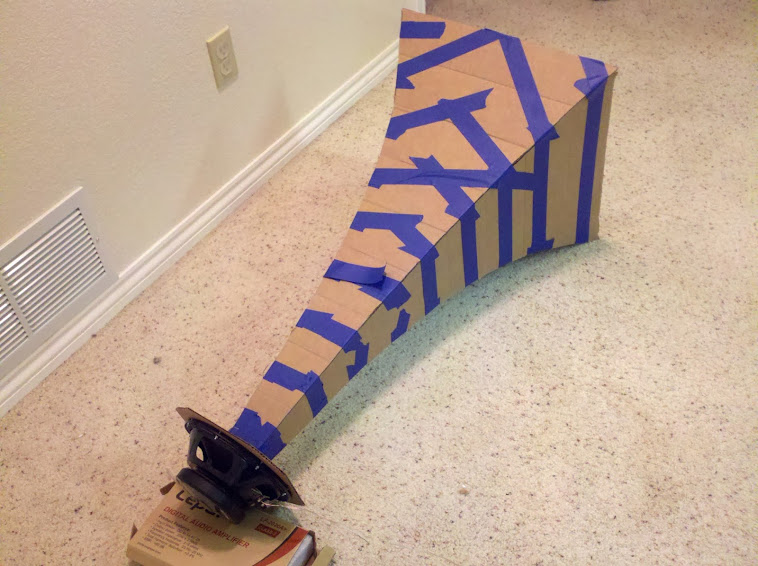
In the meantime, I'd attached one of the Alpha 8 speakers via a mounting plate to the horn. I must say, I'm addicted!
To be honest, I wasn't expecting much in the way of bandwidth - I suppose that it was in my head that it would sound like an old gramophone, but the extension was fantastic! I'm very much looking forward to finishing off the horn design, and matching it with the other components!

- Status
- This old topic is closed. If you want to reopen this topic, contact a moderator using the "Report Post" button.
- Home
- Loudspeakers
- Multi-Way
- Midbass horn
